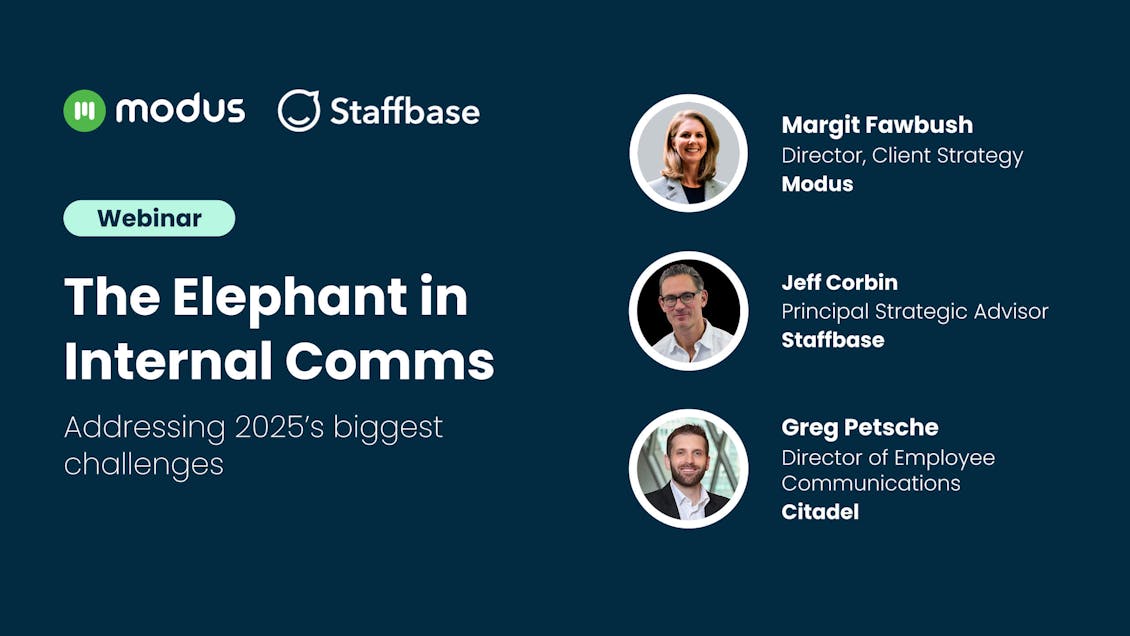Webinar recap: The Elephant in Internal Comms

How to navigate the challenges and opportunities in workplace communication today
The field of internal communications has grown significantly in recent years, evolving from a support function to a strategic pillar of organizational culture and employee experience. This shift accelerated with the rise of remote and hybrid work, as businesses realized how vital clear, consistent, and engaging communication is for aligning and motivating distributed teams.
With this rapid growth, new challenges for connection and cohesion have emerged, putting more pressure than ever on internal comms leaders to bridge the gaps and keep employees informed, engaged, and aligned.
Breaking down the challenges and opportunities facing the internal comms industry today was the topic of a recent webinar we hosted with our partner, Staffbase. Featuring Margit Fawbush, Director, Client Strategy, Modus; Jeff Corbin, Principal Strategic Advisor, Staffbase; and Greg Petsche, Director of Employee Communications, Citadel, the conversation unpacked findings from our State of Internal Communications 2025 survey and report.
They shared what’s working and what’s not for leading organizations as they address today's biggest communication hurdles.
Watch the full webinar recording to learn:
- How to engage employees with dynamic content that doesn’t overwhelm them
- Strategies for engaging frontline workers in ways that are relevant and valuable
- How to build a sense of community with intranets and comms
Top challenges: Information overload and busyness
Our survey found that the top communication challenges reported were: information overload (62%) and heavy workloads limiting time to check communications (62%).
“Their full-time job is not to read the corporate messaging,” said Greg of employees. “Part of our job is to help build that connection between their day-to-day work and the company, and to make sure that everybody is aligned with the company's strategies.”
Greg shared his strategies for avoiding information overload, starting with an audit of all communications. “Are they getting three emails a day from different functions?” he asked. “Having a good lay of the land of what exists today can then help you bring the functional stakeholders together to say, ‘Okay, I think there's better ways that we can bundle this.’”
Next, Greg suggests surveying employees to find out which content formats they prefer, such as videos or short-form articles, and reshaping content to meet their preferences.
Getting through to frontline workers
Another key finding in our industry survey pointed to the difficulty engaging frontline workers (60%). Also known as essential workers, these employees are often “unwired” and not tied to a desk, such as supply chain workers, nurses, drivers, and field workers. As they are often public-facing, frontline workers are an important part of business operations and keeping them engaged should be a high priority.
“The main challenge is you’re asking people to engage with your content on their own time,” said Greg. “How can you make your content valuable to them, so that it becomes something like a trusted form of media that they want to go?”
He highlighted tactics such as focusing on localized content, such as blogs from a plant manager and an HR manager. “That way, it wasn't just top corporate messaging coming to them, but they also had the content that was most relevant to them from the people they knew, who they would see every day, and who they have relationships with.”
Content that feels personalized can support more of what Jeff referred to as “anchor content,” or mission-critical content such as HR benefits information, pay stubs and timekeeping, or cafeteria menus, for example. “Employees come to the platform, and by default… they're now exposed to all this other nice-to-know content,” he said.
The trick to keeping intranet content engaging is to update it often, said Greg. “You have to dedicate the resourcing to feed the content to them on a regular basis so that they continue to return to the app, because anchor content is only going to do so much for you.”
Set teams up for success and build a sense of community
Rolling out new approaches to workplace comms such as a mobile intranet require a thoughtful strategy that considers all the segments of your company. Jeff pointed out that some employees simply won’t want to download a workplace app to their personal devices.
Greg shared an example of a company that invested in having representatives in their cafe during lunch to show employees how to use the Staffbase app, from setup to exhibiting valuable use cases. “Right out of the gate, we had a really strong adoption rate from our frontline employees by focusing our effort at the launch and creating targeted marketing content,” said Greg.
Despite the challenges, our survey found that an employee intranet is the most effective channel for disseminating internal comms (67%). The key for success? Creating community within the intranet, shared Jeff.
“Can you create a social opportunity for people to share ideas?” asked Jeff. “It can be anywhere from having a social wall where people can just post anything they want, they can be giving kudos to each other, or like an internal marketplace.”
Greg shared an example that makes his organization’s community feel unique. “We have a lot of employees who hold PhDs, and we have heavy engineering, so we use Pi Day every year to have some fun,” he said. “We have a puzzle and we get hundreds of people who submit the answer to the puzzle… There are fun ways to make moments relevant for your audience that's separate from the usual business that you can sprinkle in between to keep people coming back.”
In closing, the panel shared ways of measuring success, depending on specific strategies and KPIs.
Be sure to explore our comprehensive findings in our State of Internal Communications 2025 report!



